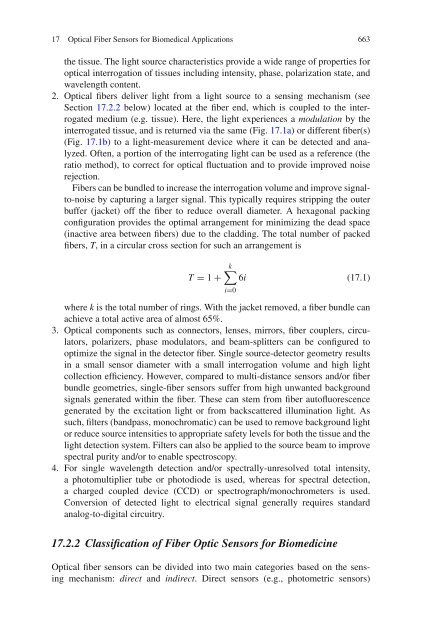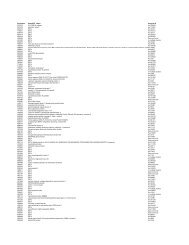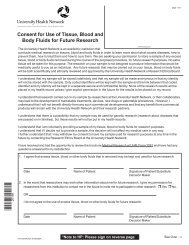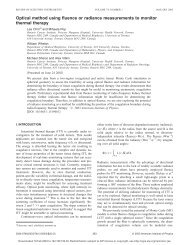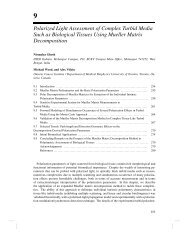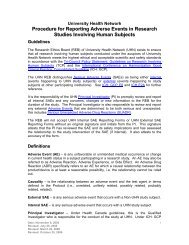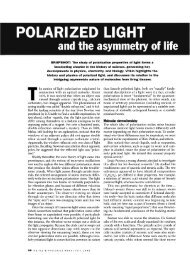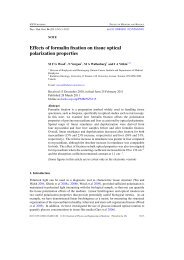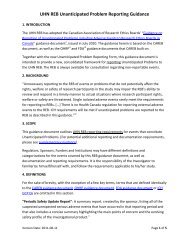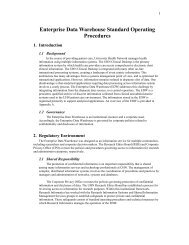Optical Fiber Sensors for Biomedical Applications
Optical Fiber Sensors for Biomedical Applications
Optical Fiber Sensors for Biomedical Applications
You also want an ePaper? Increase the reach of your titles
YUMPU automatically turns print PDFs into web optimized ePapers that Google loves.
17 <strong>Optical</strong> <strong>Fiber</strong> <strong>Sensors</strong> <strong>for</strong> <strong>Biomedical</strong> <strong>Applications</strong> 663the tissue. The light source characteristics provide a wide range of properties <strong>for</strong>optical interrogation of tissues including intensity, phase, polarization state, andwavelength content.2. <strong>Optical</strong> fibers deliver light from a light source to a sensing mechanism (seeSection 17.2.2 below) located at the fiber end, which is coupled to the interrogatedmedium (e.g. tissue). Here, the light experiences a modulation by theinterrogated tissue, and is returned via the same (Fig. 17.1a) or different fiber(s)(Fig. 17.1b) to a light-measurement device where it can be detected and analyzed.Often, a portion of the interrogating light can be used as a reference (theratio method), to correct <strong>for</strong> optical fluctuation and to provide improved noiserejection.<strong>Fiber</strong>s can be bundled to increase the interrogation volume and improve signalto-noiseby capturing a larger signal. This typically requires stripping the outerbuffer (jacket) off the fiber to reduce overall diameter. A hexagonal packingconfiguration provides the optimal arrangement <strong>for</strong> minimizing the dead space(inactive area between fibers) due to the cladding. The total number of packedfibers, T, in a circular cross section <strong>for</strong> such an arrangement isT = 1 +k∑6i (17.1)where k is the total number of rings. With the jacket removed, a fiber bundle canachieve a total active area of almost 65%.3. <strong>Optical</strong> components such as connectors, lenses, mirrors, fiber couplers, circulators,polarizers, phase modulators, and beam-splitters can be configured tooptimize the signal in the detector fiber. Single source-detector geometry resultsin a small sensor diameter with a small interrogation volume and high lightcollection efficiency. However, compared to multi-distance sensors and/or fiberbundle geometries, single-fiber sensors suffer from high unwanted backgroundsignals generated within the fiber. These can stem from fiber autofluorescencegenerated by the excitation light or from backscattered illumination light. Assuch, filters (bandpass, monochromatic) can be used to remove background lightor reduce source intensities to appropriate safety levels <strong>for</strong> both the tissue and thelight detection system. Filters can also be applied to the source beam to improvespectral purity and/or to enable spectroscopy.4. For single wavelength detection and/or spectrally-unresolved total intensity,a photomultiplier tube or photodiode is used, whereas <strong>for</strong> spectral detection,a charged coupled device (CCD) or spectrograph/monochrometers is used.Conversion of detected light to electrical signal generally requires standardanalog-to-digital circuitry.i=017.2.2 Classification of <strong>Fiber</strong> Optic <strong>Sensors</strong> <strong>for</strong> Biomedicine<strong>Optical</strong> fiber sensors can be divided into two main categories based on the sensingmechanism: direct and indirect. Direct sensors (e.g., photometric sensors)


